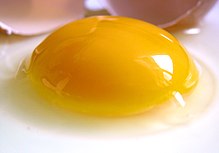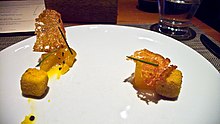


Molecular gastronomy is the scientific approach of cuisine from primarily the perspective of chemistry. The composition (molecular structure), properties (mass, viscosity, etc) and transformations (chemical reactions, reactant products) of an ingredient are addressed and utilized in the preparation and appreciation of the ingested products. It is a branch of food science that approaches the preparation and enjoyment of nutrition from the perspective of a scientist at the scale of atoms, molecules, and mixtures.

Nicholas Kurti, Hungarian physicist, and Hervé This, at the INRA in France, coined "Molecular and Physical Gastronomy" in 1988.[4]
- ^ Gadsby, Patricia (2006-02-20). "Cooking For Eggheads". Discover Magazine. Retrieved 2010-09-08.
- ^ "Eggs". Khymos.org. 2009-04-08. Retrieved 2010-09-08.
- ^ Kuh, Patric (January 1, 2005). "Proving It: Taking kitchen science to a whole new (molecular) level, Hervé This is changing the way France—and the world—cooks". gourmet.com.
- ^ "Harold McGee, Curious Cook: Modern Cooking, Science, and the Erice Workshops on Molecular and Physical Gastronomy". Curiouscook.com. Archived from the original on 2010-10-24. Retrieved 2010-09-08.